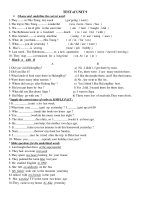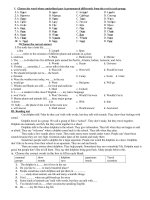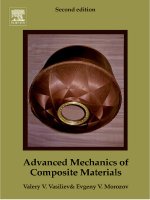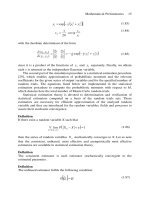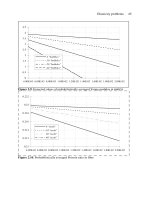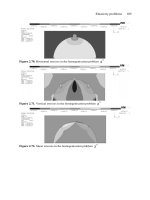Bài giảng Mechanics of Composite Material_9_2015
Bạn đang xem bản rút gọn của tài liệu. Xem và tải ngay bản đầy đủ của tài liệu tại đây (4.68 MB, 153 trang )
Mechanics of Composite
Materials
Assoc. Prof. Dr. Nguyen Trung Kien
Email: ,
Faculty of Civil engineering and Applied mechanics
HCMC University of Technology and Education
1 Vo Van Ngan Street, Thu Duc District, Ho Chi Minh City, Vietnam
September 2015
Contents
2
Introduction to composite materials
Mechanical behaviors of composite materials
Elastic behaviour of unidirectional composite materials
Elastic behaviour of orthotropic composite
Off-axis behaviour of composite materials
Fracture and damage of composite materials
Modeling of mechanical behaviours of laminated plates
Homogenization of composite materials
References
3
Jean-Marie Berthelot, Composite Materials–Mechanical
behavior and Structural analysis, Springer, 1999
J. N. Reddy, Mechanics of laminated composite plates
and shells–Theory and Analysis, CRC Press, 2004
Autar K. Kaw, Mechanics of Composite Materials,
Taylor & Francis, NewYork, 2006
S.
LI,
Introduction
to
micromechanics
nanomechanics, Lecture notes.
and
Significance & Objectives
4
Investigation of characteristics of the constituent and
composite materials
Material optimization
Development of analytical procedures for determining
material properties
Development of analytical procedures for determining
material properties
Development of analytical procedures for determining
structural behavior
Contents
5
Introduction to composite materials
Mechanical behaviors of composite materials
Elastic behavior of unidirectional composite materials
Elastic behavior of orthotropic composite
Off-axis behavior of composite materials
Fracture and damage of composite materials
Modeling of mechanical behaviors of laminated plates
Homogenization of composite materials
INTRODUCTION TO COMPOSITE MATERIALS
6
Introduction
Composite materials
o Matrix materials
o Fibers
o Architecture of composite materials
o Study the mechanical behavior of composite
materials
Application of composite materials
Composite materials
7
Old and new aspects of
composites
o Human body, plants
o Early 1960s (fibrous composites)
Definition:
“Composite” means "made of two or
more different parts
heterogeneous
All materials may be considered
heterogeneous if the scale of interest is
sufficiently small
Fibrous composites (Fiber-Reinforced
Composites) are materials in which one
phase acts as a reinforcement of a second
phase
Composite materials
8
Classification:
o Form of constituents
Fiber composite
Particle composite
o Nature of Constituents
Organic matrix composites
Metallic matrix composites
Mineral matrix composites
Particle composite
interphase Continuous phase (matrix)
Dispersed phase
(reinforcement)
Fiber composite
Composite materials
9
Classification by class of constituents
Fiber Reinforcement
Particle
Matrix
Composite
Matrix
Composite
Mechanical properties of composites
nature of the constituents
proportions of the constituents
orientation of the fibers
Properties of composite materials
10
Low-medium performance composites
The reinforcement provides stiffening and local strengthening of
the materials (short fiber)
The matrix is the main load bearing constituent governing the
mechanical properties
High performance composites
The reinforcement is the backbone of the materials (continuous
fiber)
The matrix provides protection and support for the sensitive fiber
The interphase controls the failure mechanisms
Geometric and physical definitions
11
Homogeneity
Its properties are the same at every point
(independent of location)
Nonhomogeneity (heterogeneity)
Its properties vary from point to point (depend on
location)
Isotropy
Its properties are the same in all directions
(independent of the orientation)
Anisotropy
Its properties at a point vary with direction (depend on
orientation)
Macroscopic/Microscopic
12
Macroscopic: homogeneous and anisotropic
Microscopic: nonhomogeneous and isotropic
a
b
A
B
2015-09-09
Definition of Composites
13
Nonhomogeneous anisotropic
isotropic
No conventional method
Structural analysis tool for composites required
orthotropic
anisotropic
2015-09-09
MATRIX
14
Polymer
Metal (higher use temperature)
Ceramics (very high use temperature)
MATRIX
15
Matrix: a resin (polyester, epoxide, etc.) and fillers which
is to improve the characteristics of the resin:
o Thermosetting Resins:
Polyester Resins
Condensation Resins
Epoxide Resins
o Thermoplastic Resins:
polyvinyl chloride (PVC), polyethylene, polypropylene, polystirene,
polyamide, and polycarbonate
o Thermostable Resins:
o Bismaleimide Resins, Polyimide Resins
MATRIX - RESIN
16
Any resin system for use in a composite material
will require the following properties:
1. Good mechanical properties
2. Good adhesive properties
3. Good toughness properties
4. Good resistance to environmental degradation
Composite materials
17
Epoxide Resins:
Advantages of epoxide resins are the following:
good mechanical properties (tension, bending, compression, shock, etc.)
superior to those of polyesters
good behavior at high temperatures: up to 150-190°C in continuous use
excellent chemical resistance
low shrinkage in molding process and during cure (from 0.5-1 %)
very good wettability of reinforcements
excellent adhesion to metallic materials
Disadvantages:
High cost, manufacture, sensibility to cracking
Composite materials
18
Polypropylene, polyamide:
Advantages of epoxide resins are the following:
low cost, fabrication
Disadvantages:
mechanical and thermomechanical properties : low
Limited development
Thermostable Resins: Bismaleimide Resins, Polyimide Resins
Thermal performance developed especially in the aviation and space
Composite materials
19
Fillers and additives: function of improving the mechanical and
physical characteristics of the finished product or making their manufacture
easier
Fillers: Reinforcing Fillers, Nonreinforcing Fillers
o Reinforcing Fillers : improve the mechanical properties of a resin
Spherical fillers: diameter usually lying between 10 and 150µm. They can be
glass, carbon, or organic (epoxide, phenolic, polystirene, etc.),
Nonspherical fillers: mica used most (dimension: 100-500µm, thickness: 1-20
µm)
o Nonreinforcing Fillers: reducing the cost of resins, preserving their
performance
carbonates, silicates
Additives: pigments and colorants, antishrinkage agents,
antiultraviolet agents
Composite materials
20
Fibers:
Improve mechanical characteristics: stiffness,strength, hardness, etc
Improve certain of the physical properties: thermal properties, fire
resistance, resistance to abrasion, electrical properties
Reinforcements origins: vegetable, mineral, artificial, synthetic
fibers
linear forms (strands, yarns, rovings, etc.)
surfacing tissues (woven fabrics, mats, etc.)
multidirectional forms (preforms, complex cloths, etc.)
Composite materials
21
Specific mechanical characteristics of materials, made
in the form of fibers
Composite materials
22
Specific mechanical characteristics of materials, made
in the form of fibers
Composite materials
23
Architecture of composite materials
Laminates
Composite materials
24
Architecture of composite materials
o Sandwich
Composite materials
25
Laminated composite materials
